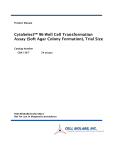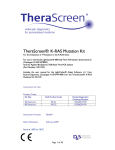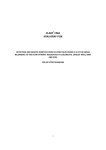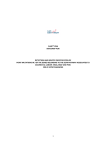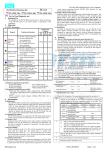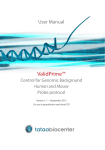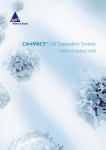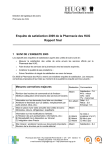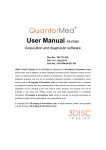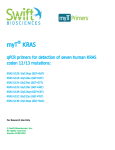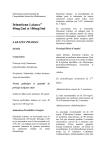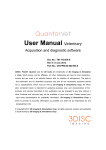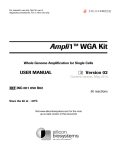Download PNAClamp™ KRAS Mutation Detection Kit (Ver.2)
Transcript
PNAClamp™ KRAS Mutation Detection Kit PNAClamp™ KRAS Mutation Detection Kit (Ver.2) For research use only Instruction manual for product # PNAC-1002 Version 4.0 Store at -15°C to -20°C Instruction Version: Ver. 4.0 Date of Revision: 2012. May 1 / 22 PNG-PCKRM002 PNAClamp™ KRAS Mutation Detection Kit Table of Contents Intended Use .......................................................................................................................................... 3 Background Information...................................................................................................................... 4 Principles and Overview....................................................................................................................... 5 Contact Information ........................................................................................................................... 6 Additional Equipment and Reagents Required ................................................................................. 6 Warnings and Precautions ................................................................................................................... 7 Components of the PNAClamp™ KRAS Mutation Detection Kit ................................................... 7 Procedures ............................................................................................................................................. 8 1. DNA Preparation .......................................................................................................................... 8 2. Preparation of the Real-Time PCR Mixture .............................................................................. 9 3. Real-Time PCR reaction ............................................................................................................ 10 4. Assessment ................................................................................................................................... 10 Examples of Analysis .......................................................................................................................... 13 References ............................................................................................................................................ 21 Endnotes .............................................................................................................................................. 22 2 / 22 PNG-PCKRM002 PNAClamp™ KRAS Mutation Detection Kit PNAClamp™ KRAS Mutation Detection Kit Please read the instructions carefully prior to use. INTENDED USE The PNAClamp™ KRAS Mutation Detection Kit is an in vitro diagnostic test to detect seven somatic mutations in the KRAS oncogene (Table 1). The PNAClamp™ KRAS Mutation Detection Kit is to be used by trained laboratory professionals, within a laboratory environment, using (for example) DNA extracted from formalin-fixed paraffin-embedded samples of lung and colorectal biopsies and surgical tissue samples. The kit is for research use only. Table 1. KRAS mutations detected by the kit No. Reagent 1 KRAS PNA mix #2 2 KRAS PNA mix #3 Exon 2 Amino Acid Change Nucleotide change Cosmic No. p.G12D p.G12A p.G12V p.G12S p.G12R p.G12C c.35G>A c.35G>C c.35G>T c.34G>A c.34G>C c.34G>T 521 522 520 517 518 516 p.G13D c.38G>A 532 Cosmic Nos are taken from the Catalogue of Somatic Mutations in Cancer. (http://www.sanger.ac.uk/genetics/CGP/cosmic) 3 / 22 PNG-PCKRM002 PNAClamp™ KRAS Mutation Detection Kit BACKGROUND INFORMATION The KRAS mutation is found in several cancers including colorectal, lung, thyroid, and pancreatic cancers and cholangiocarcinoma. KRAS mutations are often located within codons 12 and 13 of exon 2, which may lead to abnormal growth signaling by the p21-ras protein. These alterations in cell growth and division may trigger cancer development as signaling is excessive. A KRAS mutation often serves as a useful prognostic marker of drug response. For example, a KRAS mutation is considered to be a strong prognostic marker of response to tyrosine kinase inhibitors such as gefitinib (Iressa) or erlotinib (Tarceva). Recently, KRAS mutations have been detected in many colorectal cancer patients and may be associated with responses to cetuximab (Erbitux) or panitumumab (Vectibix), which are used in colon cancer therapy. 4 / 22 PNG-PCKRM002 PNAClamp™ KRAS Mutation Detection Kit PRINCIPLES AND OVERVIEW The PNAClamp™ KRAS Mutation Detection Kit is based on peptide nucleic acid (PNA)-mediated real-time PCR clamping technology. PNA is a synthetic DNA analog in which the phosphodiester backbone is replaced by a peptide-like repeat formed by (2-aminoethyl)-glycine units. Since PNA contains no charged phosphate groups, the binding between PNA/DNA is stronger than between DNA/DNA due to the lack of electrostatic repulsion. In addition, PNA is resistant to DNases and proteases, and is stable at wide range of pH. PNA-mediated real-time PCR clamping relies on the following two unique properties of PNA probes. First, PNA will hybridize to its complementary DNA target sequence only if the sequence is in complete match. Since PNA/DNA duplexes are more thermodynamically stable than the corresponding DNA-DNA duplexes, even with a single mismatch, PNA will not bind to complementary DNA strand, unlike DNA. Second, PNA oligomers are not recognized by DNA polymerases and will not be utilized as primers in subsequence real-time PCR. Instead, it serves as a sequence-selective clamp that prevents amplification during subsequent PCR. When there is a mutation in target gene and therefore a mismatch is present, the DNA/PNA duplex is destabilized, allowing strand elongation from a bound DNA oligomer which serves as a PCR primer. The outcome is the positive reaction in real-time PCR from the samples harboring mutant allele, while amplification of the wild-type gene is suppressed. Figure 1. Principle of the PNAClamp™ KRAS Mutation Detection Kit 5 / 22 PNG-PCKRM002 PNAClamp™ KRAS Mutation Detection Kit The PNAClamp™ KRAS Mutation Detection Kit can rapidly detect KRAS mutation (within 2 h) with high sensitivity even with a small amount of DNA (10~25 ng). The detection limit of the kit, when the mutated gene is mixed with wild type background, is less than 1%. CONTACT INFORMATION The PNAClamp™ KRAS Mutation Detection Kit should be kept frozen on arrival. For any questions including technical support or concerns, please contact the distributors or the manufacturer. Manufacturer: Panagene Inc. 816 Tamnip-dong, Yuseong-gu Email: [email protected] Daejeon 305-510, South Korea Tel: +82-42-861-9296 ADDITIONAL EQUIPMENT AND REAGENTS REQUIRED Reagents and equipment for DNA extraction 0.2 ml DNase-free PCR tubes or plates Pipettes A real-time PCR instrument fitted with a detector enabling evaluation of SYBR Green dye Table 2. List of real time PCR machines that have been tested Company Model Bio-Rad CFX 96 Roche Light cycler 480 II ABI ABI 7500 ABI ABI 7900 For other instruments, minor optimization might be necessary. 6 / 22 PNG-PCKRM002 PNAClamp™ KRAS Mutation Detection Kit WARNINGS AND PRECAUTIONS All experiments should be performed under proper sterile conditions with aseptic techniques. Always wear powder-free gloves when you handle the kit. To avoid repeated freezing and thawing, aliquot all reagents into appropriate volumes and store frozen until use. Thaw appropriate volumes of reagents before each experiment. All experimental procedures should be performed at room temperature. However, exposing KRAS PNA 2X premix at room temperature should be minimized for the optimal amplification. Dissolve reagents completely and mix them thoroughly by vortexing. The KRAS PNA 2X premix solution contains fluorescence dye and should be kept dark. If DNA has been extracted from a paraffin block, additional purification steps may be required. PCR tubes should be centrifuged briefly before use. Use extreme caution to prevent contamination of PCR reactions with synthetic control material. Using non-recommended volume for reagents not only result in loss of performance but also increase the chance of false result. Using non-recommended volume and concentration for target DNA sample not only result in loss of performance but also increase the change of false result. Avoid mixing with different lots or other manufacture’s product. Upon using instruments, use only recommended consumables only. If not, instruments will not be usable or false result may prominent. Additional validation testing by user may necessary when using non-recommended instruments. Do not re-use any remaining reagents after PCR amplification is completed. Do not use the reagents beyond the expiry date. Components of the PNAClamp™ KRAS Mutation Detection Kit Store at -15°C to -20°C No. Name of component Description Volume 1 Non PNA mix #1 Primers only 120 µl 2 KRAS PNA mix #2 Codon 12 PNA and primers 120 µl 3 KRAS PNA mix #3 Codon 13 PNA and primers 120 µl 4 KRAS PNA 2X premix PCR reaction premix 1,250 µl 5 Clamping control Wild type DNA 250 µl *Each kit contains enough material to test 30 DNA samples for all mutations. 7 / 22 PNG-PCKRM002 PNAClamp™ KRAS Mutation Detection Kit PROCEDURES Figure 2. Flow of the PNAClamp™ KRAS Mutation Detection Kit 1. DNA preparation Specimen collection and DNA extraction reagents are not included in the kit and should be provided by the user. 1) Specimens that can be analyzed using the PNAClamp™ KRAS Mutation Detection Kit are paraffin embedded tissues or biopsy tissues. 2) We strongly recommend using High Pure PCR Template Preparation Kit (Roche Diagnostics, catalog number 11796828001) for DNA extraction, especially for paraffin embedded tissues. 3) Specimen transport: Use standard pathology methodology to ensure specimen quality. 4) Extracted DNA can be stored at 4ºC for up to 24 hours, or at -20ºC for long term storage. 8 / 22 PNG-PCKRM002 PNAClamp™ KRAS Mutation Detection Kit 2. Preparation of the Real-Time PCR Mixture Table 3. Set up reaction mix per one reaction Components Volume KRAS PNA 2X Premix (#4) 10 µl Each PNA mix (#1~#3) 3 µl Extracted DNA (10~25 ng total) or Clamping Control (#5) 7 µl Total volume 20 µl 1) Prepare 3 PCR tubes for one set of DNA samples to be tested. Label them as S1, S2, and S3. Prepare another set of 3 tubes for Clamping Control (wild-type DNA) and label them as C1~C3. 2) Add 10 µl of KRAS PNA 2X Premix (#4 from the kit) to each tube. 3) For each PCR tube, add 3 µl of corresponding PNA mix from #1~3 from the kit. For example, S1 and C1 tubes will have #1 Non PNA mix #1, S2 and C2 tubes will have #2 KRAS PNA mix #2 and so forth. 4) For S1~S3 PCR tubes, add 7 µl of prepared DNA sample (10~25 ng total) to each tube to yield 20 l final volume. 5) For C1~C3 PCR tubes, add 7 µl of Clamping Control (#5 from the kit). 6) If you have more than one DNA samples to be tested, prepare one set of clamping control for the entire experiment. In such case, it is recommended to prepare a master mix containing 2X Premix and each PNA mix for all the samples and to aliquot 13 µl to each PCR tube. 7) When all reagents are loaded, tightly close/seal the PCR tube or 96 well plate. Otherwise, any remaining reagents may evaporate. 9 / 22 PNG-PCKRM002 PNAClamp™ KRAS Mutation Detection Kit 3. Real-Time PCR reaction 1) Perform real-time PCR using the cycling conditions described below: ONE CYCLE Pre-denaturation 94ºC 5 min FOUR-STEP CYCLING (40 CYCLES) Denaturation 94ºC 30 sec PNA clamping 70ºC 20 sec Annealing 63ºC 30 sec Extension* 72ºC 30 sec 2) Set up the detection for reading SYBR Green at 72ºC. 4. Assessment * Refer to the instrument user manual for detail analysis method. A. Clamping Control (wild-type DNA control) 1) Determine Ct value from each PCR reaction. The cycle number at which a signal is detected above background fluorescence is termed as the cycle threshold (Ct). 2) The Ct values of the wild-type DNA control (tube C1~C3) should fall in the range given in Table 4. The assay should be repeated if the values are not in recommended range. Table 4. The acceptable Ct ranges of Clamping Control Assay Acceptable Ct range 23≤ X ≤ 27 ① Non PNA mix #1 (C1) ② KRAS PNA mix #2 (C2) > 33 ③ KRAS PNA mix #3 (C3) > 34 B. DNA samples 1) Determine Ct values of each sample (S1~S3). i. Ct value of Non PNA mix (S1) should be 22~34. ii. Ct value of Non PNA mix (S1) can serve as an internal to indicate the purity and the concentration of sample DNA. Thus, the validity of the test can be decided by the Ct value of Non PNA mix (S1) as shown in Table 5. 10 / 22 PNG-PCKRM002 PNAClamp™ KRAS Mutation Detection Kit iii. If the Ct value of Non PNA mix (S1) is equal to or greater than 34, target gene was not successfully amplified and therefore the result is not reliable. Check DNA amount and purity. New DNA prep might be required. iv. If the Ct value of Non PNA mix (S1) is equal to or less than 22, the result may be false positive. Repeat the PCR reaction with lower amount of DNA. v. If the Ct value of Non PNA mix (S1) is between 30 and 35 (30≤ Ct <34), the target gene was amplified with low efficiency. For more reliable result, it is suggested to repeat PCR reaction with a higher amount of DNA. Table 5. The acceptability of the test Acceptability Ct value of S1 Optimal 22< Ct <30 Acceptable 30≤ Ct <34 Descriptions and recommendations The amplification and the amount of DNA sample are optimal. The target gene was amplified with low efficiency. For more reliable result, it is suggested that repeat PCR reaction with a higher amount of DNA. Possibility of false positive is high. Repeat the PCR reaction with a lower amount of DNA. The amplification was failed. Check DNA amount and purity. New DNA prep might be required. Ct ≤ 22 Invalid 34≤ Ct 2) Calculate the ΔCt-1 values by subtracting the sample Ct values from the Standard Ct values given in Table 6. If the Ct of DNA samples is displayed as NA (not applicable), then set Ct value as 38 for further calculation. *ΔCt-1 = [Standard Ct] – [Sample Ct (S2 or S3)] Table 6. The value of Standard Ct Standard Ct Instrument KRAS PNA mix #2 KRAS PNA mix #3 Bio-Rad CFX96 35 36 Roche LC480 35 35 ABI 7900 34 35 ABI 7500 35 35 3) Calculate ΔCt-2 [Ct value of sample subtracted by Ct value of Non PNA mix]. **ΔCt-2 = [Sample Ct (S2 or S3)] – [Non PNA mix Ct (S1)] 11 / 22 PNG-PCKRM002 PNAClamp™ KRAS Mutation Detection Kit 4) Assess the result for each KRAS PNA mix along with the values of ΔCt-1 and ΔCt-2 as given in Table 7. Table 7. Assessment of the result for each KRAS PNA mix (S2 or S3) ΔCt-1 ΔCt-2 Assessment 2≤ ΔCt-1 All value Mutant ΔCt-2 <6 Mutant 6≤ ΔCt-2 Wild All value Wild 0< ΔCt-1 <2 ΔCt-1 ≤0 5) Assess the result along with the result for each KRAS PNA mix as given in Table 8. Table 8. Final assessment of the result of sample DNA KRAS PNA mix #2 (S2) KRAS PNA mix #3 (S2) Result Wild Wild Wild-type Mutant Wild Wild Mutant Mutant Mutant 12 / 22 KRAS codon 12 mutant type KRAS codon 13 mutant type KRAS codon 12 and KRAS codon 13 mutant type PNG-PCKRM002 PNAClamp™ KRAS Mutation Detection Kit EXAMPLES OF ANALYSIS 1. Using Bio-Rad CFX96 1) Profile of Clamping Control and DNA sample ① Sample Non PNA mix #1 ② Sample KRAS PNA mix #2 ③ ④ ⑤ ⑥ Sample KRAS PNA mix #3 Clamping control Non PNA mix #1 Clamping control KRAS PNA mix #2 Clamping control KRAS PNA mix #3 Table 9. Example of sample Ct values Assay Sample No. Sample 1 Ct Sample 2 Ct Sample 3 Ct Sample 4 Ct Standard **ΔCt-2 *ΔCt-1 Ct ① Non PNA mix #1 (S1) 28.84 24.22 27.38 26.18 ② KRAS PNA mix #2 (S2) 32.76 38 38 27.38 35 (⑦) ②-① ⑦-② ③ KRAS PNA mix #3 (S3) 39.35 28.9 38 32.76 36 (⑧) ③-① ⑧-③ *ΔCt-1 = [Standard Ct] – [Sample Ct] **ΔCt-2 = [Sample Ct] – [Non PNA mix Ct (S1)] 13 / 22 PNG-PCKRM002 PNAClamp™ KRAS Mutation Detection Kit Table 10. Analysis of data Sample No. Sample 1 Sample 2 Sample 3 Sample 4 ΔCt-2 ΔCt-1 ΔCt-2 ΔCt-1 ΔCt-2 ΔCt-1 ΔCt-2 ΔCt-1 ②KRAS PNA mix #2 (S2) 3.92 2.24 13.78 -3 10.62 -3 1.2 7.62 ③KRAS PNA mix #3 (S3) 10.51 -3.35 4.68 7.1 10.62 -2 6.58 3.24 Assay Results KRAS codon 12 mutant type KRAS codon 13 mutant type Wild-type KRAS codon 12 and KRAS codon 13 mutant type 1. When ΔCt-1 is equal to or greater than 2, the sample is assessed to be mutated ( 2. If ΔCt-1 is greater than 0 and less than 2 ( ). ), then ΔCt-2 needs to be determined. 3. If ΔCt-2 is less than 6, the sample is assessed to be mutated ( ). 4. Final assessments are as follows. Table 11. Final assessment of the result of sample DNA Sample No. KRAS PNA mix #2 KRAS PNA mix #3 Results Sample 1 Mutant Wild KRAS codon 12 mutant type Sample 2 Wild Mutant KRAS codon 13 mutant type Sample 3 Wild Wild Wild-type Mutant KRAS codon 12 and KRAS codon 13 mutant type Sample 4 Mutant 14 / 22 PNG-PCKRM002 PNAClamp™ KRAS Mutation Detection Kit 2. Using Roche LC480 1) Profile of Clamping Control and DNA sample ① Sample Non PNA mix #1 ② Sample KRAS PNA mix #2 ③ Sample KRAS PNA mix #3 ④ Clamping control Non PNA mix #1 ⑤ Clamping control KRAS PNA mix #2 ⑥ Clamping control KRAS PNA mix #3 Table 12. Example of sample Ct values Sample No. Standard Ct **ΔCt-2 *ΔCt-1 35.00 35 (⑦) ②-① ⑦-② 35.00 35 (⑧) ③-① ⑧-③ Sample 1 Ct Sample 2 Ct Sample 3 Ct ① Non PNA mix #1 (S1) 24.72 25.11 24.74 ② KRAS PNA mix #2 (S2) 28.34 35.00 ③ KRAS PNA mix #3 (S3) 38.00 32.75 Assay *ΔCt-1 = [Standard Ct] – [Sample Ct] **ΔCt-2 = [Sample Ct] – [Non PNA mix Ct (S1)] 15 / 22 PNG-PCKRM002 PNAClamp™ KRAS Mutation Detection Kit Table 13. Analysis of data Sample No. Sample 1 Sample 2 Sample 3 ΔCt-2 ΔCt-1 ΔCt-2 ΔCt-1 ΔCt-2 ΔCt-1 ②KRAS PNA mix #2 (S2) 3.62 6.66 9.89 0 10.26 0 ③KRAS PNA mix #3 (S3) 13.28 -3.00 7.64 2.25 10.26 0 Assay Results KRAS codon 12 mutant type KRAS codon 13 mutant type Wild-type 1. When ΔCt-1 is equal to or greater than 2, the sample is assessed to be mutated ( 2. If ΔCt-1 is greater than 0 and less than 2 ( ). ), then ΔCt-2 needs to be determined. 3. If ΔCt-2 is less than 6, the sample is assessed to be mutated ( ). 4. Final assessments are as follows. Table 14. Final assessment of the result of sample DNA Sample No. KRAS PNA mix #2 KRAS PNA mix #3 Results Sample 1 Mutant Wild KRAS codon 12 mutant type Sample 2 Wild Mutant KRAS codon 13 mutant type Sample 3 Wild Wild Wild-type 16 / 22 PNG-PCKRM002 PNAClamp™ KRAS Mutation Detection Kit 3. Using ABI 7900 1) Profile of Clamping Control and DNA sample ① Sample Non PNA mix #1 ② Sample KRAS PNA mix #2 ③ Sample KRAS PNA mix #3 ④ Clamping control Non PNA mix #1 ⑤ Clamping control KRAS PNA mix #2 ⑥ Clamping control KRAS PNA mix #3 Table 15. Example of sample Ct values Sample No. Standard Ct **ΔCt-2 *ΔCt-1 36.88 34 (⑦) ②-① ⑦-② 36.70 35 (⑧) ③-① ⑧-③ Sample 1 Ct Sample 2 Ct Sample 3 Ct ① Non PNA mix #1 (S1) 24.88 24.84 24.95 ② KRAS PNA mix #2 (S2) 27.95 35.76 ③ KRAS PNA mix #3 (S3) 35.45 31.99 Assay *ΔCt-1 = [Standard Ct] – [Sample Ct] **ΔCt-2 = [Sample Ct] – [Non PNA mix Ct (S1)] 17 / 22 PNG-PCKRM002 PNAClamp™ KRAS Mutation Detection Kit Table 16. Analysis of data Sample No. Sample 1 Sample 2 Sample 3 ΔCt-2 ΔCt-1 ΔCt-2 ΔCt-1 ΔCt-2 ΔCt-1 ②KRAS PNA mix #2 (S2) 3.07 6.05 10.92 -1.76 11.93 -2.88 ③KRAS PNA mix #3 (S3) 10.57 -0.45 7.15 3.01 11.75 -1.7 Assay Results KRAS codon 12 mutant type KRAS codon 13 mutant type Wild-type 1. When ΔCt-1 is equal to or greater than 2, the sample is assessed to be mutated ( 2. If ΔCt-1 is greater than 0 and less than 2 ( ) ), then ΔCt-2 needs to be determined. 3. If ΔCt-2 is less than 6, the sample is assessed to be mutated ( ). 4. Final assessments are as follows. Table 17. Final assessment of the result of sample DNA Sample No. KRAS PNA mix #2 KRAS PNA mix #3 Results Sample 1 Mutant Wild KRAS codon 12 mutant type Sample 2 Wild Mutant KRAS codon 13 mutant type Sample 3 Wild Wild Wild-type 18 / 22 PNG-PCKRM002 PNAClamp™ KRAS Mutation Detection Kit 4. Using ABI 7500 1) Profile of Clamping Control and DNA sample ① ② ③ ④ ⑤ ⑥ Sample KRAS PNA mix #1 Sample KRAS PNA mix #2 Sample KRAS PNA mix #3 Clamping control Non PNA mix #1 Clamping control KRAS PNA mix #2 Clamping control KRAS PNA mix #3 Table 18. Example of sample Ct values Sample No. Standard Ct **ΔCt-2 *ΔCt-1 38.60 35 (⑦) ②-① ⑦-② 37.63 35 (⑧) ③-① ⑧-③ Sample 1 Ct Sample 2 Ct Sample 3 Ct ① Non PNA mix #1 (S1) 25.07 25.33 25.27 ② KRAS PNA mix #2 (S2) 28.05 37.34 ③ KRAS PNA mix #3 (S3) 38.00 32.82 Assay *ΔCt-1 = [Standard Ct] – [Sample Ct] **ΔCt-2 = [Sample Ct] – [Non PNA mix Ct (S1)] 19 / 22 PNG-PCKRM002 PNAClamp™ KRAS Mutation Detection Kit Table 19. Analysis of data Sample No. Sample 1 Sample 2 Sample 3 ΔCt-2 ΔCt-1 ΔCt-2 ΔCt-1 ΔCt-2 ΔCt-1 ②KRAS PNA mix #2 (S2) 2.98 6.95 12.01 -2.34 13.33 -3.60 ③KRAS PNA mix #3 (S3) 12.93 -3.00 7.49 2.18 12.36 -2.63 Assay Results KRAS codon 12 mutant type KRAS codon 13 mutant type Wild-type 1. When ΔCt-1 is equal to or greater than 2, the sample is assessed to be mutated ( 2. If ΔCt-1 is greater than 0 and less than 2 ( ). ), then ΔCt-2 needs to be determined. 3. If ΔCt-2 is less than 6, the sample is assessed to be mutated ( ). 4. Final assessments are as follows. Table 20. Final assessment of the result of sample DNA Sample No. KRAS PNA mix #2 KRAS PNA mix #3 Results Sample 1 Mutant Wild KRAS codon 12 mutant type Sample 2 Wild Mutant KRAS codon 13 mutant type Sample 3 Wild Wild Wild-type 20 / 22 PNG-PCKRM002 PNAClamp™ KRAS Mutation Detection Kit REFERENCES 1. Choi et al., Frequency of KRAS, BRAF, and PIK3CA mutations in advanced colorectal cancers: Comparison of peptide nucleic acid-mediated PCR and direct sequencing in formalin-fixed, paraffin-embedded tissue. Pathol Res Pract 207 (12):762-8, 2011. 2. Yoon et al., K-ras Gene Mutation in Non-Small Cell Lung Cancer. J Lung Cancer 1(1):55-59, 2002. 3. Beau-Faller et al., Detection of K-Ras mutations in tumour samples of patients with nonsmall cell lung cancer using PNA-mediated PCR clamping. British Journal of Cancer 100(6): 985 – 992, 2009. 4. Chang et al., Fast simultaneous detection of K-RAS mutations in colorectal cancer. BMC cancer 9:179, 2009. 5. Dabritz et al., Detection of Ki-ras mutations in tissue and plasma samples of patients with pancreatic cancer using PNA-mediated PCR clamping and hybridisation probes. British Journal of Cancer 92(2): 405-412, 2005. 6. Behn et al., Facilitated detection of oncogene mutations from exfoliated tissue material by a PNA-mediated `enriched PCR' protocol. J. Pathol 190(1):69-75, 2000. 7. Hilger et al., The Ras-Raf-MEK-ERK Pathway in the Treatment of Cancer. Onkologie 25(6): 511-518, 2002. 8. Bachireddy et al., Getting at MYC through RAS. Clin Cancer Res 11(12):4278-4281, 2005. 21 / 22 PNG-PCKRM002 PNAClamp™ KRAS Mutation Detection Kit ENDNOTES This product is for research only, not for a diagnostic tool or for any other use. The kit itself or any of the components in the kit cannot be modified, resold or transferred without the approval of manufacturer. Information in this document is subject to change. Panagene assumes no responsibility for any errors that may appear in this document. No other warranties of any kind, express or implied, including without limitation, implied warranties of merchantability or fitness for a particular purpose, are provided by Panagene. Panagene shall have no liability for any direct, indirect, consequential, or incidental damages arising out of the use, the results of use, or the inability to use this product. PANAGENE Inc. 816 Tamnip-dong, Yuseong-gu, Daejeon 305-510, Korea Tel: +82-42-861-9296 www.panagene.com 22 / 22 PNG-PCKRM002






















